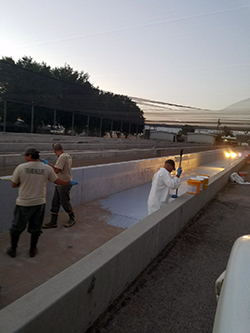
Working late, Mojave River hatchery staff apply FDA-certified epoxy coating to hatchery rearing ponds.
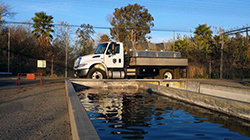
CDFW fish transportation truck at Fillmore Hatchery
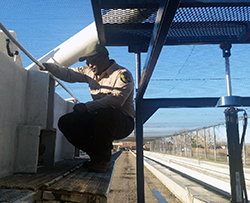
Acting Mojave River Hatchery Manager Forest Williams at work
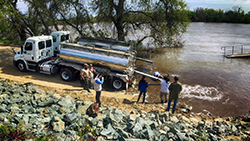
A hatchery crew releases trout into the Feather River
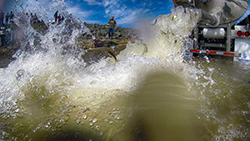
A fishy view of trout planting on the Feather River
The beginning of trout fishing season in Southern California is just around the corner, and CDFW biologists and hatchery staff are striving to maximize hatchery trout availability for the many anglers who will cast lines in coming weeks. Trout angling in lower-elevation waters of Southern California generally begins in November and continues through April, to correspond with colder water temperatures that can sustain stocked trout.
Precise temperatures are just one of the criteria that must be met before trout stocking begins. Currently, these conditions are approaching optimal levels, but CDFW is running about two weeks behind schedule due to unforeseen circumstances at Mojave River and Fillmore trout hatcheries, two of CDFW’s southernmost facilities.
The Mojave River Hatchery, built in 1947, raises and stocks a ten-year average of 340,000 pounds of catchable trout per year. Beginning in June of this year, extensive maintenance and facility upgrades necessitated turning off the water for a six-month period. While the completed upgrades will ultimately result in better and more efficient trout production for Southern California, the project ran about two months behind schedule. Water is scheduled to flow again at Mojave River Hatchery in late November and the hatchery will be populated with fingerling trout for fast growth. Mojave’s year-round water temperatures yield fast trout growth resulting in maximized yield in minimal time.
While the Mojave River Hatchery was closed, Fillmore Hatchery, built in 1941 on the Santa Clara River, experienced a significant loss of trout inventory intended for Southern California angling due to gas bubble disease. Gas bubble disease is a result of supersaturated gasses (oxygen, nitrogen and carbon dioxide) present in well water pumped from a deep aquifer. While Fillmore Hatchery is equipped to aerate this water and make it suitable for trout, an unknown variable (possibly a drought-depleted and then recharged aquifer) overwhelmed that ability. In an average year, Fillmore Hatchery produces about 400,000 trout for lakes and streams in Southern California. To reduce fish losses from gas bubble disease in the last several weeks, catchable fish were stocked from Fillmore to appropriate waters, and some fish were transferred to other hatcheries. Ultimately, the gas bubble disease at Fillmore resulted in a loss of about 50 percent of inventory. While emergency measures taken by Fillmore staff and
CDFW fish pathologists resulted in better conditions and lower gas super-saturation, the hatchery must be depopulated so that the issue can be addressed entirely. As soon as all trout are removed, hatchery staff and scientists will increase the gas diffusion capability of aeration towers at Fillmore, in order to handle supersaturated well water for the short and long term.
The status of these two hatcheries presented a substantial problem for trout stocking in Southern California that was solved in part by hatcheries in Central and Northern California. These hatcheries have sufficient catchable size trout to supply Southern California’s approved waters immediately and in coming weeks. Thanks to strategic planning and trout production at a statewide level, Northern and Central California can supply fish to Southern California without impacting originally scheduled trout releases in their respective areas.
Trout stocking for Southern California waters will begin this week and hatchery trucks are on the move. Hatchery staff will work quickly to distribute trout to as many approved waters as possible. Trout stocking to Southern California will initially be lighter than usual, but will likely pick back up in 2018. As Mojave River Hatchery comes back online, fish transferred to that facility will be fed and reared to maximize daily growth. We anticipate another large batch of catchable trout available for Southern California toward early spring 2018.
Hatchery staff will be doing everything possible, statewide, to maximize trout production and releases to approved waters in the coming months. Staff work diligently for the angling public and appreciate their continued support.
The statewide planting schedule is updated in real time online.
CDFW photos. Top: Steelhead trout at Mokelumne River Hatchery